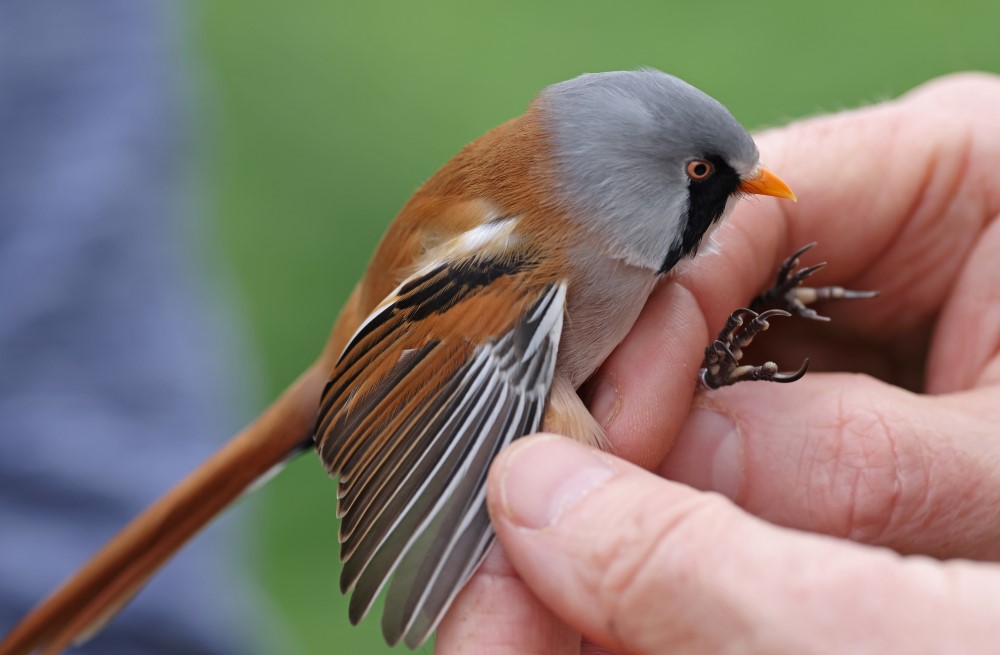Recent activities

The return of Bearded Tits to Rye Meads
Bearded Tits have been very irregular winter visitors to Rye Meads in recent years. Why are they so irregular? Where do they come from? Might they stay to breed? Alan Harris shares what we know so far and ponders the factors affecting their behaviour.
A flock of overwintering Bearded Tits which eventually settled in the Lee Marsh have been very popular with visitors this winter. They have been frustratingly elusive to the point where we still do not have a definitive number for the flock. This winter the Bearded Tits were first noted on 11 October 2022 in the meadows; the RMRG trapped and ringed two. That day six were seen to drop in from high and later ten were together in the Draper Reedbed, whilst even later that day some (six?) Bearded Tits were photographed in the Lee Marsh by the Ashby hide. So the grand total for that day lies between ten and sixteen –who knows? And whether they all remained is unclear; in some years Bearded Tit visits have been short and they have quickly moved on.
Visitors have been naturally curious about the Beardies and many wonder how often they occur here, where they come from, if they will stay to breed or if they have ever bred at Rye Meads?
RMRG began work studying the birds of Rye Meads in 1960 and first recorded Bearded Tits on 12 October 1961 – a flock of 17. Bearded Tits were recorded in five ‘winters’ in the 1960s, usually in late autumn/early winter, only actually staying to overwinter in 1964/65. Overwintering became regular in the 1970s and early 80s (with the exceptions of 1971-72 and 1976-77) with a peak of 40 birds in 1978-79. This period of overwintering ended after 1983-84 winter. What caused this period of overwintering?
Well, our phragmites reedbeds were probably less than 20% of what they are today, and much of that reed was growing in channels and ditches with only three larger patches, at the north end of Lee Marsh (near the Kingfisher hub), and in the meadows in front of the Warbler hide and (the biggest and deepest bed, known as Priors Square) to the north and now obliterated by the Stansted Abbotts bypass. Interestingly though, it wasn’t the reedbeds that the Bearded Tits favoured, apart from to roost in. Instead they foraged during the day along the new gravel workings of Stansted Abbotts GPs, both to the north and later the south of the Toll road. Here they fed in primary vegetation, mainly in willowherb and fat-hen. Gradually secondary growth in the form of scrub invaded these feeding grounds. The loss of Priors Square to the bypass cannot be implicated in the demise of overwintering, since Bearded Tits ceased to winter before construction started, but its destruction may well have discouraged passing Beardies from stopping at Rye Meads thereafter.
Where did these winterers come from, and why?
The British Bearded Tit population increased rapidly throughout the 1960s and 70s, fuelled in part by immigrants from a beleaguered Dutch population which had grown to over 20,000 birds and whose reedbed habitat was suddenly under threat. Earlier land reclamation had created huge reedbeds on the reclaimed polders which were now being turned over to agriculture. The arrival of the Dutch into a growing British population saw a new phenomenon–autumn irruptions. Crowded Bearded Tits began to seek new reedbeds, and these late autumn irruptions spread the Bearded Tits into new areas, some of which were colonised. Sadly, Rye Meads, without extensive reedbeds for breeding in but good for wintering, was not.
Ringing at this time showed some fascinating insights. Birds wintering at Rye Meads initially came from Walberswick (125km NE) and Minsmere (123km NE), from Knardijk, Ijsselmeer, Netherlands (370km NE), and later in the 70s from four colonies in Kent, from Titchwell in Norfolk and more birds from Suffolk. In the 1977-78 winter the Bearded Tit flock contained ringed birds from both Suffolk and Kent. One Minsmere ringed bird wintered at Rye Meads in both the 1972-73 and 1973-74 winters, and eight birds originally ringed at Rye Meads were recaptured again at Rye Meads in a subsequent winter.
Why did it all stop? Well, the habitat succession already alluded to may have been a factor making Rye Meads less attractive, but the general phenomenon of autumn irruptions in the UK certainly faded away, perhaps as Bearded Tits had redistributed themselves and felt less crowded and compelled to move. Nationally the population may have suffered in the hard winters of the late 1970s and early 1980s.
Following the 1983-84 winter Bearded Tits almost ceased to occur at Rye Meads. In the 38 winters up to 2021-2022 there were only seven visitations, consisting of three brief late autumn appearances, and four of overwintering; in 2002-2003 (three birds), 2010-2011 (five), 2016-17 (three) and 2019-2020 (three). Efforts to catch and ring these birds have proved worthwhile and we continue to be rewarded with fascinating revelations. A male caught on 12 February 2011 had been ringed at Haddiscoe Island, Suffolk on 24 July 2010 (141km SW).
In 2012 three were caught and ringed on 10 November and remained until the 11th. Two of these (both females) told a remarkable story. They were relocated in a tiny reedbed in the Serpentine, Hyde Park, in central London on 11 December 2021. They remained there until at least 13 January 2013, the first to be found in Inner London. One of them was later controlled at Belton Marshes, Norfolk (144km NE) on 17 August 2013!
In 2016 three were found on 12 December, and apparently overwintered. When caught on 12 February 2017 the group was found to include a male ringed at Kingfisher Bridge, Cambs (64km SSW) on 17 May 2016.
Bearded Tits have never bred at Rye Meads and actually summer records have been very rare – just four; a male from 21 April to 1 June 1975, one on 14 May 1980, a male from 17-24 May 2003 (which wore a ring and led to speculation that he may have been one of the wintering birds last seen in the February of that year). In 2015 a male was seen on 12 April.
All reedbed specialists have their own optimum reedbed habitat –Bitterns like it over deep water, Water Rails like it welly boot depth, Reed Warblers also favour the long straight reed growing in water. For breeding, Bearded Tits like the drier beds with plenty of reed debris on the floor where they hide their nests. Rye Meads reedbeds were mainly of that poorer, drier type in the 1970s, so it was disappointing that they never stayed to breed.
Nowadays, with 80% more reed on site the potential for Bearded Tits to breed seems higher but much of the new reed which has developed since 2000 was created for Bitterns, and remains wet, as do the reedbeds in the meadows due to inundation from the treatment works. Nevertheless there would still seem to be plenty of Bearded Tit-type reedbed, so we are ever optimistic, we live in hope.

[…] The Bearded Tits reported earlier in the winter have been sighted intermittently, up to 6 birds on four dates. Are they staying at some remote reedbed in a little watched part of the site, or are they roaming around the wider area? See Alan Harris’s excellent review of Bearded Tits at Rye Meads. […]